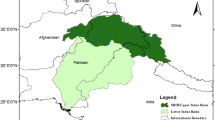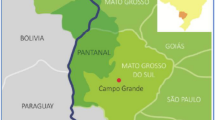Abstract
The estimation of maximum rainfall at different return periods (T) receives a crucial role in the precise planning of irrigation systems, hydraulic structures, and drainage systems. The design of such structures should be done in such a way that these structures should not be damaged due to extreme rainfall events in their entire life. The probability/frequency analysis of maximum rainfall is necessary for the selection of an appropriate model that could anticipate extreme natural processes like rainfall and flood. This study aims to select the best probability distribution function (PDF) and extrapolate maximum rainfall magnitudes at different time scales for higher durations of T in the Parbhani district of Maharashtra state of India. The maximum rainfall analysis for the study area was accomplished using daily rainfall data of 49 years (1971 to 2019). Weibull’s plotting position (WPP) formula was used to estimate observed rainfall magnitudes at different durations of T. Different PDFs like Gumbel extreme value (GEV), log-Pearson type III (LP-III), Pearson type III (P-III), log normal (L-NM), and normal (NM) were used at different time scales for estimation of annual, maximum monthly, and consecutive 1, 2, 3, 4, and 5 days of maximum rainfall. The estimated magnitudes of maximum rainfall were compared with the results of the WPP. The chi-square test was used for the selection of the best-fitting PDF for the study area. In this study, GEV PDF performed the best for annual, maximum monthly, and 1 day and consecutive 5 days of maximum rainfall estimation while LP-III PDF performed the best for consecutive 2, 3, and 4 days of maximum rainfall estimation of the study area. The values of maximum rainfall at different time scales were extrapolated for the 100- and 200-year durations of T using the selected PDF for the study area. These findings will help design engineers and planners in the construction of adequate drainage systems and hydraulic structures. The result of this study will be useful to formulate the appropriate strategy against flood hazards and damages.












Similar content being viewed by others
References
Ahmad I, Ahmad T, Almanjahie IM (2019) Modelling of extreme rainfall in Punjab: Pakistan using bayesian and frequentist approach. Appl Ecol Environ Res 17(6):13729–13748
Alahmadi F (2019) Evaluation of the efficiency of conventional and unconventional probability distribution functions for rainfall frequency models in arid environments. 8th International Conference on Water Resources and Arid Environments. ICWRAE 8:76–81
Alam MA, Emura K, Farnham C, Yuan J (2018) Best-fit probability distributions and return periods for maximum monthly rainfall in Bangladesh. Climate 6:9. https://doi.org/10.3390/cli6010009
Amin TA, Rizwan M, Alazba AA (2016) A best-fit probability distribution for the estimation of rainfall in northern regions of Pakistan. Open Life Science 11:432–440
Asim M, Nath S (2015) Study on rainfall probability analysis at Allahabad district of Uttar Pradesh. J Biol Agric Healthc 5(11):214–222
Bhakar SR, Iqbal M, Devanda M, Chhajed N, Bansal AK (2008) Probability analysis of rainfall at Kota. Indian J Agric Res 42(3):201–206
Bhatt VK, Tiwari AK, Sharma AK (1996) Probability models for prediction of annual maximum daily rainfall for Datia. Indian Journal of Soil Conservation 24(1):25–27
Coronado-Hernández ÓE, Merlano-Sabalza E, Díaz-Vergara Z, Coronado-Hernández JR (2020) Selection of hydrological probability distributions for extreme rainfall events in the regions of Colombia. Water 12(5):1397. https://doi.org/10.3390/w12051397
Chaudhari RR, Sharma P (2021) An integrated stochastic approach for extreme rainfall analysis in the National Capital Region of India. J Earth Syst Sci 130:16. https://doi.org/10.1007/s12040-020-01510-0
Chow VT (1951) General formula for hydrological frequency analysis. Trans Am Geographic Union 32:231–237
Dabral PP, Kumar A, Tana G (2016) Determination of surface drainage coefficient - a case study of Doimukh (Arunachal Pradesh). Int. J. Agric. Eng 18(4):1–10
Derakhshannia M, Dalvand S, Asakereh B, Ostad-Ali-Askari K (2020) Corrosion and deposition in Karoon River, Iran, based on hydrometric stations. Int. J. Hydrol. Sci. Technol 10(4):334–345. https://doi.org/10.1504/IJHST.2020.108264
Esberto MDP (2018) Probability distribution fitting of rainfall patterns in Philippine regions for effective risk management. Environ Ecol Res 6(3):178–186
Ferdows M, Hossain M (2005) Flood frequency analysis at different rivers in Bangladesh: a comparison study on Probability distribution functions. Thammasat Int J Sci Tech 10(3):53–62
Ghosh S, Roy MK, Biswas SC (2016) Determination of the best fit probability distribution for monthly rainfall data in Bangladesh. Am. J. Math Stat 6(4):170–174
Haan CT (1994) Statistical methods in hydrology. Affiliated East West Press Pvt ltd., New Delhi
Hassan MUI, Hayat O, Noreen Z (2019) Selecting the best probability distribution for at-site flood frequency analysis; a study of Torne River. SN Applied Sciences 1:1629. https://doi.org/10.1007/s42452-019-1584-z
Izinyon OC, Ajumuka HN (2013) Probability distribution models for flood prediction in Upper Benue River Basin – Part II. Civil Environ Res 3(2):62–74
Kaur L, Anvesha KM, Verma SL, Kumar P (2021) Annual maximum rainfall prediction using frequency analysis for Roorkee, Uttarakhand. India Mausam 72(2):359–372
Kousar S, Khan AR, Hassan MU, Noreen Z, Bhatti SH (2020) Some best-fit probability distributions for at-site flood frequency analysis of the Ume River. J. Flood Risk Manag 13:e12640. https://doi.org/10.1111/jfr3.12640
Kumar R, Bhardwaj A (2015) Probability analysis of return period of daily maximum rainfall in annual data set of Ludhiana Punjab. Indian J. Agric. Res 49(2):160–164
Kumar V, Shanu J (2017) Statistical distribution of rainfall in Uttarakhand, India. Appl Water Sci 7:4765–4776
Langat PK, Kumar L, Koech R (2019) Identification of the most suitable probability distribution models for maximum, Minimum, and Mean Streamflow. Water 11:734
Li Z, Li Z, Zhao W, Wang Y (2015) Probability modeling of precipitation extremes over two river basins in Northwest of China. Adv in Meteorol. https://doi.org/10.1155/2015/374127
Moccia B, Mineo C, Ridolfi E, Russo F, Napolitano F (2021) Probability distributions of daily rainfall extremes in Lazio and Sicily, Italy, and design rainfall inferences. J. Hydrol. Reg. Stud 33:100771. https://doi.org/10.1016/j.ejrh.2020.100771
Nwaogazie IL, Sam MG (2019) Probability and non-probability rainfall intensity-duration-frequency modeling for port-harcourt metropolis. Int J Hydrol 3(1):66–75
Namitha MR, Vinothkumar V (2019) Development of empirical models from rainfall -intensity-duration-frequency curves for consecutive days maximum rainfall using GEV distribution. J. pharmacogn. phytochem 8(1):2705–2709
Ojha CSP, Berndtsson R, Bhunya P (2008) Engineering hydrology. Oxford University Press, New Delhi
Ostad-Ali-Askari K, Kharazi HG, Shayannejad M, Zareian MJ (2019) Effect of management strategies on reducing negative impacts of climate change on water resources of the Isfahan-Borkhar aquifer using MODFLOW. River Res Appl 35(6):611–631. https://doi.org/10.1002/rra.3463
Ostad-Ali-Askari K, Kharazi HG, Shayannejad M, Zareian MJ (2020) Effect of climate change on precipitation patterns in an arid region using GCM models: case study of Isfahan-Borkhar Plain. Nat Hazard Rev 21(2):04020006. https://doi.org/10.1061/(ASCE)NH.1527-6996.0000367
Ostad-Ali-Askari K, Shayannejad M, Eslamian S, Navabpour B (2018) Comparison of solutions of Saint-Venant equations by characteristics and finite difference methods for unsteady flow analysis in open channel. Int. J. Hydrol. Sci. Technol 8(3):229–243. https://doi.org/10.1504/IJHST.2018.093569
Ostad-Ali-Askar K, Su R, Liu L (2018) Editorial: water resources and climate change. J. Water Clim. Change 9(2):239. https://doi.org/10.2166/wcc.2018.999
Ostad-Ali-Askari et al (2017) Deficit irrigation: optimization models. Management of Drought and Water Scarcity. Handbook of Drought and Water Scarcity 3:373–389. https://doi.org/10.1201/9781315226774
Pegu M, Malik RK (2015) Prediction of maximum monthly rainfalls for different return periods using frequency factor analysis for Dhemaji Region in Assam, India. Int. J. Eng. Res 4(9):165–169
Pirnazar et al (2018) The evaluation of the usage of the fuzzy algorithms in increasing the accuracy of the extracted land use maps. Int. J. Glob. Environ 17(4):307–321. https://doi.org/10.1504/IJGENVI.2018.095063
Prakash C, Rao DH (1986) Frequency analysis of rainfall data for crop planning - Kota. Indian Journal Soil Conservation 14(20):23–26
Rahman AS, Rahman A, Zaman MA, Haddad K, Ahsan A, Imteaz M (2013) A study on selection of probability distributions for at-site flood frequency analysis in Australia. Nat Hazards 69(3):1803–1813
Sabarish RM, Narasimhan R, Chandhru AR, Suribabu CR, Sudharsan J, Nithiyanantham S (2017) Probability analysis for consecutive-day maximum rainfall for Tiruchirapalli City (south India, Asia). Appl Water Sci 7:1033–1042
Saleh HM, Mahmoud HH, Abdou MI, Eskander SB (2021) Health risk assessment based on metal analysis of soil and crops in Al-Dakhla Oasis. Arab J Geosci 14:260. https://doi.org/10.1007/s12517-021-06597-3
Salehi-Hafshejani et al (2019) Determination of the height of the vertical filter for heterogeneous Earth dams with vertical clay core. Int. J. Hydrol. Sci. Technol 9(3):221–235. https://doi.org/10.1504/IJHST.2019.102315
Samantaray S, Sahoo A (2020) Estimation of flood frequency using statistical method: Mahanadi River basin, India. H2Open Journal 3(1):189–207. https://doi.org/10.2166/h2oj.2020.004
Sharma I, Mishra SK, Pandey A (2021) A simple procedure for design flood estimation incorporating duration and return period of design rainfall. Arab J Geosci 14:1286. https://doi.org/10.1007/s12517-021-07645-8
Singh A, Thakur S, Adhikary NC (2021) Analysis of spatial and temporal rainfall characteristics of the North East region of India. Arab J Geosci 14:885. https://doi.org/10.1007/s12517-021-07266-1
Singh AK, Singh YP, Mishra VK, Arora S, Verma CL, Verma N, Verma HM, Srivastav A (2016) Probability analysis of rainfall at Shivri for crop planning. J Soil Water Conserv 15(4):306–312
Singh RK (2001) Probability analysis for prediction of maximum daily rainfall of Eastern Himalaya (Sikkim Mid Hills). Indian Journal of Soil Conservation 29(3):263–265
Subramanya K (2009) Engineering hydrology. Chapter 7, McGraw Hill Book Co. Inc., New Delhi.
Subudhi R (2007) Probability analysis for prediction of annual maximum daily rainfall of Chakapada block of Kandhamal district in Orissa. Indian Journal of Soil Conservation 35:84–85
Tabish M, Ahsan MJ, Mishra AR (2015) Probability analysis for prediction of annual maximum rainfall of one to seven consecutive days for Ambedkar Nagar Uttar Pradesh. Int. J. Agric. Sci 6(1):47–54
Talebmorad H, Ahmadnejad A, Eslamian S, Ostad-Ali-Askari K, Singh VP (2020) Evaluation of uncertainty in evapotranspiration values by FAO56-Penman-Monteith and Hargreaves-Samani methods. Int. J. Hydrol. Sci. Technol 10(2):135–147. https://doi.org/10.1504/IJHST.2020.106481
Talebmorad et al (2021) Evaluation of the impact of climate change on reference crop evapotranspiration in Hamedan-Bahar plain. Int. J. Hydrol. Sci. Technol 11(3):333–347. https://doi.org/10.1504/IJHST.2021.114554
Topaloglu F (2002) Determining suitable probability distribution models for flow and precipitation series of Seyhan River Basin. Turk J Agric for 26:187–194
Upadhyaya A, Singh SR (1998) Estimation of consecutive days maximum rainfall by various methods and their comparison. Indian Journal of Soil Conservation 26(2):193–201
Vanani et al (2017) Development of a new method for determination of infiltration coefficients in furrow irrigation with natural non-uniformity of slope. Sustain. Water Resour. Manag 3:163–169. https://doi.org/10.1007/s40899-017-0091-x
Waghaye AM, Siddenki V, Kumari N (2015) Design rainfall estimation using probabilistic approach for Adilabad district of Telangana. Int. J. Adv. Sci. Res 2(5):301–318
Ye L, Hanson LS, Ding P, Wang D (2018) Vogel RM (2018) The probability distribution of daily precipitation at the point and catchment scales in the United States. Hydrol Earth Syst Sci 22:6519–6531. https://doi.org/10.5194/hess-22-6519-2018
Zamir F, Hanif F, Naz S (2021) Extreme rainfall frequency analysis for Balakot, Pakistan, using Gumbel’s distribution. Arab J Geosci 14:1283. https://doi.org/10.1007/s12517-021-06780-6
Author information
Authors and Affiliations
Corresponding author
Ethics declarations
Conflict of Interest
The authors declare no competing interests.
Additional information
Responsible Editor:Broder J. Merkel
Rights and permissions
About this article
Cite this article
Bajirao, T.S. Comparative performance of different probability distribution functions for maximum rainfall estimation at different time scales. Arab J Geosci 14, 2138 (2021). https://doi.org/10.1007/s12517-021-08580-4
Received:
Accepted:
Published:
DOI: https://doi.org/10.1007/s12517-021-08580-4




